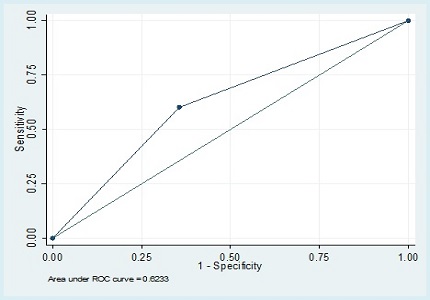Role of chest x-ray in assessing severity of pneumonia in children aged 3 months to 59 months
Abstract
Introduction: Pneumonia is the leading cause of death in children worldwide. Accurate assessment of severity and prognosis is important to decide management of pneumonia. The objective of present study is to study role of Chest X-ray in predicting severity of pneumonia in children.
Material & Methods: A total of 307 children aged 3 months to 59 months diagnosed with Pneumonia & Severe pneumonia as per World Health Organization (WHO) criteria were included in study. Chest radiographs were reported by Pediatric Radiologist and findings classified as Normal, Primary End point consolidation, Other Infiltrates, Pleural effusion. Results were compared in sub-group i.e. Pneumonia & Severe Pneumonia.
Result: Hypoxia, cyanosis, grunting and severe malnutrition were found to be poor predictors of radiographic pneumonia. Bilateral infiltrates (30%) & Primary end point consolidation on right side (17%) are independent determinant of severity of pneumonia. Bilateral consolidation and bilateral pleural effusion on chest X-ray are associated with poor outcome.
Conclusion: Children with cyanosis, grunting, hypoxia & severe malnutrition should preferentially have chest Xray done since they are more likely to have consolidation, infiltrates or pleural effusion. Children with Bilateral infiltrates, Consolidation and Bilateral pleural effusion should preferably be admitted to pediatric intensive care unit for more aggressive monitoring and management, since they have poor outcome.
Downloads
References
2. Nelson Textbook of Pediatrics .20th ed. Kleigman, Staton , St Geme and Schor, 2015:2088-2089.
3. Farooqui H, Jit M, Heymann DL, Zodpey S. Burden of Severe Pneumonia, Pneumococcal Pneumonia and Pneumonia Deaths in Indian States: Modelling Based Estimates. PLoS One. 2015 Jun 18;10(6):e0129191. doi: 10.1371/journal.pone.0129191. eCollection 2015.
4. Causes of neonatal and child mortality in India: A nationally representative mortality survey-Causes-of-neonatal-and-child- mortality-in-India-2010.pdf. Available from: http://cghr.org/wordpress/wp-content/ uploads/ Causes-of-neonatal-and-child-mortality-in-India-2010.
5. Revised WHO classification and treatment of childhood pneumonia at health facilities. Geneva ,World Health organization, 2014 : 19-20.
6. Cherian T, Mulholland EK, Carlin JB, Ostensen H, Amin R, de Campo M, Greenberg D, Lagos R, Lucero M, Madhi SA, O'Brien KL, Obaro S, Steinhoff MC. Standardized interpretation of paediatric chest radiographs for the diagnosis of pneumonia in epidemiological studies. Bull World Health Organ. 2005 May;83(5):353-9. Epub 2005 Jun 24.
7. Campos JM (1998) Haemophilus. In: Murday PR (editor) Manual of clinical microbiology. (7th edn) Washington. PC: p604.
8. Sheikh Q, Zulfiqar B. Role of chest X-ray in diagnosis of lower respiratory tract infections in children less than 5 years of age in community. Pak. J Med Sc: October-December 2005 Vol. 21 No. 4: 417 -421.
9. Patria MF, Longhi B. Association between radiological findings and severity of community-acquired pneumonia in children. Italian Journal of Pediatrics 2013, 39:56. doi:
10.1186/1824-7288-39-56.
10. Tiewsoh K, Lodha R, Pandey RM, Broor S, Kalaivani M, Kabra SK. Factors determining the outcome of children hospitalized with severe pneumonia. BMC Pediatr. 2009 Feb 23;9:15. doi: 10.1186/1471-2431-9-15.
11. Basnet S, Sharma A, Mathisen M, Shrestha PS, Ghimire RK Shrestha DM, Valentiner-Branth P, Sommerfelt H, Strand TA. Predictors of duration and treatment failure of severe pneumonia in hospitalized young Nepalese children. PLoS One. 2015 Mar 23;10(3):e0122052. doi: 10.1371/journal.pone.0122052. eCollection 2015.
12. Bharti B, Kaur L, Bharti S. Role of chest X-ray in predicting outcome of acute severe pneumonia. Indian Pediatr. 2008 Nov;45(11):893-8. [PubMed]
13. Handbook IMCI. Integrated Management of Childhood Illness. By World Health Organization (WHO). 2005.
14. Patel A, Bang A, Singh M et .al. A Randomized Controlled Trial of Home based Oral Amoxicillin for severe Pneumonia in children aged 3-59 months : The India CLEN Severe Pneumonia Oral Therapy Study .BMC Pediatrics. 2015 ,Nov .15:186 : DOI: 10.1186/s12887-015-0510-9.
15. Jackson S, Mathews KH, Pulanić D, Falconer R, Rudan I, Campbell H, Nair H. Risk factors for severe acute lower respiratory infections in children–a systematic review and meta-analysis. Croatian medical journal. 2013 Apr 15;54(2):110-21.
16. Use and interpretation of anthropometric indicators of nutritional status. WHO Working Group. Bull World Health Organ. 1986;64(6):929-41. [PubMed]
17. K Park. Park’s Textbook of Preventive and Social Medicine. 23rd ed. 2015.
18. Sudha Basnet, Ramesh Kant Adhikari and Chitra Kumar Gurung. Hypoxemia in Children with Pneumonia and Its Clinical Predictors. Indian Journal of Pediatrics. Volume 73- September, 2006.
19. Principi N, Esposito S: Management of severe community-acquired pneumonia of children in developing and developed countries. Thorax 2011, 66:815–822. Doi 10.1136/thx2010.142604. [PubMed]
20. Mathisen M, Strand TA, Sharma BN, Chandyo RK, Valentiner-Branth P, Basnet S, Adhikari RK, Hvidsten D, Shrestha PS, Sommerfelt H. Clinical presentation and severity of viral community-acquired pneumonia in young Nepalese children. Pediatr Infect Dis J. 2010 Jan;29(1):e1-6. doi: 10.1097/INF.0b013e3181c2a1b9.
21. Kuti BP, Adegoke SA et al. Can we predict which children with clinical pneumonia will have radiologic findings on chest radiograph?. World Journal of Medicine and Medical Science: 2014 March ; 2(3): 1–12.ISSN 2330-1341.
22. Ali Salih KEM, Wahb OA, Ibrahim SA Radiological Findings in Severe Pneumonia in Children 1-59 Months in a Children’s Hospital, Khartoum, Sudan. Pediatr Therapeut.2012; 2:117. doi:10.4172/2161-0665.1000117.
23. Jerald P kuhn, Thomas l Slovis, jack O Haller. Caffey’s Pediatric Diagnostic Imaging. 10th ed , volume 1: 987-995.
24. Bay A, Etlik O, Oner AF, Unal O, Arslan H, Bora A, Davran R, Yuca SA, Dogan M. Radiological and clinical course of pneumonia in patients with avian influenza H5N1. Eur J Radiol. 2007 Feb;61(2):245-50. Epub 2006 Nov 15.
25. Mark I Neuman. Prediction of pneumonia in pediatric emergeny department. Paediatrics, vol 128, number 2, Aug 2011.DOI 10: 1016/j.ejrad. 2006.10.006.
26. EI Chima et al. Determinants of In-Hospital Mortality From Community Acquired Pneumonia In Nigerian Adults: A Five Year Multi-Centre Case- Control Study. ATS Journals. D108. Pneumonia Epidemiology And Outcomes. May , 2014: A6514-A6514.

Copyright (c) 2017 Author (s). Published by Siddharth Health Research and Social Welfare Society

This work is licensed under a Creative Commons Attribution 4.0 International License.


 OAI - Open Archives Initiative
OAI - Open Archives Initiative


